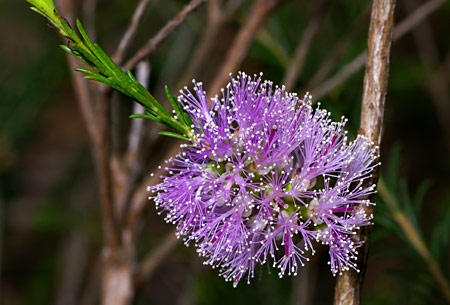Rosy Paperbark
(Melaleuca diosmatifolia)
Rosy Paperbark (Melaleuca diosmatifolia)
/
/

Unknown authorUnknown author
CC BY 3.0 au
Image By:
Unknown authorUnknown author
Recorded By:
Copyright:
CC BY 3.0 au
Copyright Notice:
Photo by: Unknown authorUnknown author | License Type: CC BY 3.0 au | License URL: https://creativecommons.org/licenses/by/3.0/au/deed.en | Uploader: Gderrin | Publisher: Wikimedia Commons | Title: Melaleuca_diosmatifolia_flowers.jpg | Notes: User created page with UploadWizard |
























Estimated Native Range
Summary
Melaleuca diosmatifolia, commonly known as Rosy Paperbark, is an evergreen shrub native to coastal swamps, wet heathlands, and boggy areas in Eastern Australia. It typically grows to a height of about 1.5 meters (5 feet) with hard, rough grey bark. The shrub is notable for its dense clusters of pinkish-purple to deep mauve flowers, which are arranged on spikes up to 40 mm (2 in) long and 20 mm (0.8 in) in diameter. These spikes, containing 15 to 50 flowers each, appear mainly from November to December and may continue through to May. The flowers are particularly showy due to their numerous stamens, with five (rarely six) bundles per flower and 15 to 26 stamens per bundle. After flowering, the plant produces woody capsules about 2–3 mm (0.08–0.1 in) long.
The Rosy Paperbark is valued for its hardiness and the longevity of its attractive flowers, which do not fade as quickly as those of the related Melaleuca decussata. It is often used as a screening plant in gardens and landscapes. This species thrives in a wide range of soil conditions, including poorly drained soils, and is tolerant of both full sun and part shade. It requires low to medium amounts of water and prefers soils with medium drainage. The Rosy Paperbark can be easily propagated from seed or cuttings and responds well to pruning, which helps maintain a bushy shape. However, gardeners should be aware that it can become weedy if not managed properly in cultivation.CC BY-SA 4.0
The Rosy Paperbark is valued for its hardiness and the longevity of its attractive flowers, which do not fade as quickly as those of the related Melaleuca decussata. It is often used as a screening plant in gardens and landscapes. This species thrives in a wide range of soil conditions, including poorly drained soils, and is tolerant of both full sun and part shade. It requires low to medium amounts of water and prefers soils with medium drainage. The Rosy Paperbark can be easily propagated from seed or cuttings and responds well to pruning, which helps maintain a bushy shape. However, gardeners should be aware that it can become weedy if not managed properly in cultivation.CC BY-SA 4.0
Plant Description
- Plant Type: Shrub
- Height: 7-9 feet
- Width: 4-6 feet
- Growth Rate: Moderate
- Flower Color: Purple
- Flowering Season: Spring, Summer
- Leaf Retention: Evergreen
Growth Requirements
- Sun: Full Sun, Part Shade
- Water: Medium
- Drainage: Medium
Common Uses
Bee Garden, Bird Garden, Butterfly Garden, Hedges, Hummingbird Garden, Low Maintenance, Showy Flowers
Natural Habitat
Coastal swamps, wet heathlands, and boggy areas
Other Names
Common Names: Pink Honey-Myrtle
Scientific Names: , Melaleuca diosmatifolia, Melaleuca erubescens, Melaleuca armillaris var. tenuifolia, Melaleuca ericifolia var. erubescens, Melaleuca fraseri, Melaleuca cylindrica, Myrtoleucodendron cylindricum,
GBIF Accepted Name: Melaleuca diosmatifolia Dum.Cours.